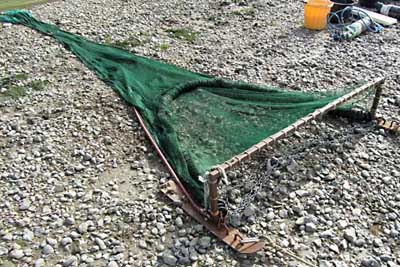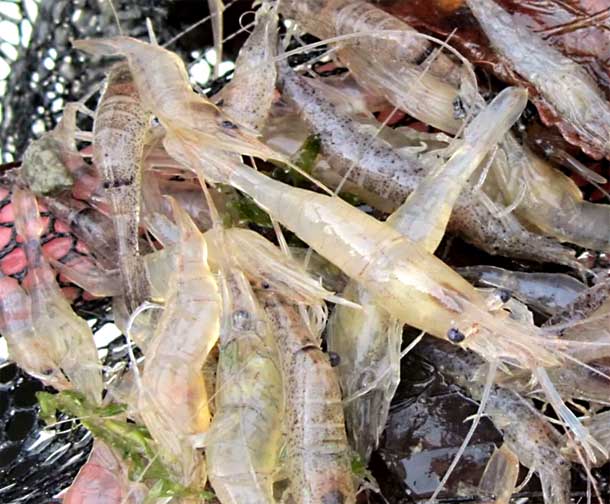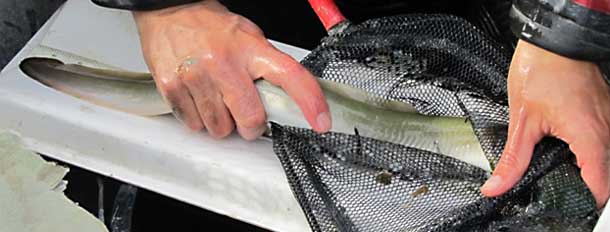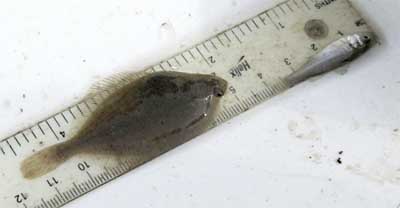When the TAC attended their second set of fish surveys with the Environment Agency on the Thames at Richmond and Battersea, little did we know that bass, flounders, gobies and prawns would be gracing the nets, more than 60 miles inland from the sea.
The Environment Agency fisheries team contacted TAC because they wanted to engage with Thames anglers, so as a result, we found ourselves welly deep in the tidal silt observing their annual fish surveys.
Electro fishing is used upriver, but due to the salinity in the tidal reaches, the amount of current required would be too high to be practical. Hence the use of nets, mainly Seine and trawl beams. At low water, a boat drags the Seine net (see header picture) from the shore out to mid river in an arc then back to the shore, before it is hauled in by hand.

A second method used, is to drag the trawl beam behind the boat, at high speed along the river bottom.
Bigger fish are generally wise enough to vacate the area but smaller fish are caught and it’s those that indicate the river’s future. Four members of the EA fisheries team then counted and measured the fish before returning them.
The knowledge of the fisheries team is truly impressive. They are able to identify multiple species of fish an inch long without a second glance; sometimes it seemed just by the fish’s eyes.
Richmond 27th September 2010
Richmond Bridge at low water is essentially fresh water. Species netted here were bleak, dace, roach, minnow (very rare on the tidal apparently – I’d never seen such excitement over a minnow), eel (elver size so nice to see), bullhead, sticklebacks, perch and incredibly… (this is Richmond in Surrey!) … gobies, bass and prawns. From an area a few dozen yards across, that’s 10 species.
 |
| Have you seen a goby in the Thames before? |
Gobies are more commonly associated with beach rock pools than the river in Surrey.
As anglers we were stunned by the sheer volume of small silvers. Think again how much groundbait you use – you may need to double it with this quantity of fish picking at it.
There were more roach than any other species, followed by dace; all looked 1st, 2nd, 3rd year fish, but it was amazing to net sea fish by Richmond Bridge, especially bass. Trending data isn’t available yet, but the gut feeling from the fisheries team is the river is as healthy as in previous years. Alas, no junior zander, pike, bream, barbel or carp which we were looking out for.
Some of the EA fisheries team are anglers (one is a member of the PAC) and it was very clear they care as much about what goes on as we do. They are also disgusted by poaching, pollution spills and sewage outfalls.
The angling world in general has done them a massive disservice. We moan they don’t check licenses but that is because they are busy building and preserving fish habitat, pollution clear ups and crucially, closing down illegal netting operations. They’ve stopped 5 illegal nettings this year on the tidal. This means they may not be around to check licences full time and it may mean the odd angler gets away with taking fish for the pot, but that’s nothing compared to the loss of fish they have prevented from nets and long lines.
Battersea 30th September 2010
Seven bridges downstream from Richmond, the water starts to get brackish at Battersea and there was a difference in species seen. Gone were the bleak, dace, minnow, bullhead and sticklebacks. Dace spawn a few hundred yards away at Wandsworth so it was a surprise to see none on this occasion. What we did net at Battersea though is a very healthy 8 species. Good numbers of baby bream, abundant 3oz roach, eels, perch, flounders, bass, gobies and large numbers of smelt. The current record smelt is only 6oz 12 drams so they provide a ready meal for other fish.
 |
| Thames smelt 60 miles inland from the sea |
Smelt is a well known pike bait so you would think, therefore, that the tidal Thames would be thick with pike – not so. In all the years of the EA fisheries team netting the tidal Thames annually from Richmond, Kew, Chiswick, Battersea, Greenwich and Thurrock no pike has been netted, not even fry. The only pike seen was adult but dead. Studies have shown pike fry do not survive even in quite low salinity. They survive in brackish water longer if at low temperatures but the Thames is warm compared to the colder extents of Esox Lucius’s territory.
Pike being present in the Baltic Sea is often quoted as an example of pike surviving brackish water but the Baltic Sea is deep, with salt water in its depths and freshwater nearer the surface layers, which is where the pike are to be found.
From the same studies, it was found that pike fry can, however, survive low salinity levels if exposed to it for only a short time. This would fit the profile, for example, of the semi tidal river at Teddington, Twickenham and Richmond, which is essentially fresh water with tidal influxes of low salinity. The science pointing to pike survival in this environment also fits with angling reports.
Pike captures on the full tideway, especially in brackish water from Battersea and even further down, would be of interest in building up a better picture of predators on the tidal Thames. Any reported to the TAC will be fed back to the EA, with the captor’s permission.
The tide tables are naturally a reference for most tidal anglers but something happened at the Battersea netting which will influence the way I fish on the tidal Thames. If I wasn’t privileged enough to see it I would no doubt waste many hours fishing the wrong stage of the tide over the coming years, so I would like to share it with you.
Slack water at low tide lasted only 3 or 4 minutes. The EA filled a net immediately at slack and then one straight after – maybe 7 or 8 minutes later – by then the tide had started coming in. The second net’s contents were completely different from the first net, despite covering the same part of the river.
First net at slack water caught coarse fish plus smelt. Second net was all sea fish (plus eel). As soon as the tide starts to come in, the coarse fish move away from the incoming salinity, back up river to fresher water. Or, they may allow themselves to be swept along with the tide. I saw with my own eyes that on the tidal in the brackish stretches such as Battersea, you are best advised to fish for coarse silvers on the ebb or slack. If you leave it till when the tide is coming in, the coarse fish are simply no longer present for you to catch.
This was entirely in accordance with what the fisheries team expected, based on previous nettings and seems regular tidal fish behaviour.
On the subject of how to fish with an edge on the tidal Thames, take a look into one of the many nets of natural food we caught.

Marine crustacea – prawns and brown shrimp many miles from the sea at Battersea
There were masses of prawns and marine shrimps caught in the nets – probably one shrimp for every three fish. These must be one of the reasons why such an abundance of fish is supported on the tidal Thames. At the Richmond Bridge netting, we found 3 or 4 prawns. At Battersea there were dozens and dozens in a very small area of river. If you were wondering what to use as bait on the tidal Thames, you now know what the fish are eating.
 |
| Typical stamp of roach netted at Battersea |
A surprise was to see bream this far down, but they were there in numbers and were all in top condition, as were the roach. Roach thrive on other tidal rivers and with the Thames riverbed thick with small snails and small crustaceans, as well as the large prawns we’ve seen, I wonder what roach secrets the tidal Thames holds.
Encouragingly, the EA team said they are seeing a lot more elvers than in previous years – their scientists haven’t established why yet, though it is great news.

Hopefully with the higher numbers of elvers in the Thames this year, some will grow in time to this size and bigger

Pictured left: A tiny flounder and bass from the Thames at Battersea
Steve Holmes – Thames Anglers’ Conservancy










